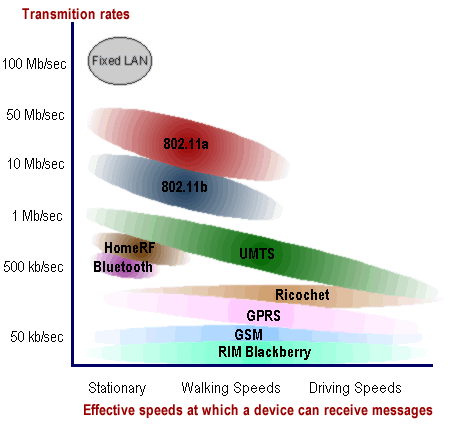 |
|
|
|
The Golden Age of Wireless...
A golden age of wireless is coming ... really! Despite the proliferation of cell phones and PDAs, very few handheld devices are currently being used to access the Internet and fewer still are used as a conduit to access Information Management Systems. Today's wireless landscape is still nascent - standards are far from being established and competing systems are in a battle for mind and market share. And the battlefield is littered with the blooded bodies of yesterday's heroes. It seems like yesterday that WAP (Wireless Access Protocol) was going to take the world by storm, but perhaps the most memorable thing to emerge from the early days of the WAP revolution was the slogan: "WAP is Crap". WAP is not the only standard who's fortunes have risen and fallen and risen overnight. Bluetooth can be everyone's darling one day and the next ... well who knows what tomorrow will bring?
Which standard is best? And for which application? Well of course the proponents of each will tell you that theirs is. And they may be right. The simple answer is: "it depends". It depends on what you want to accomplish and in what environment. If you want to move a massive amount of data very quickly in an enclosed environment (location based services), say a hospital of a university setting, then you'll want to look closely at the 802.11x standards. If, on the other hand, you need access to always on email, (small data packets) in any location and at any speed, well then, the Blackberry would seem to be your obvious choice. And in between? Well, "that's the rub" isn't it? In between you'll find Bluetooth and HomeRF, (connects devices at short ranges) And GSM, GRPS, Ricochet and UMTS (connects devices at longer ranges). But this may be a misleading over simplification. Things are not that simple here either, ...that would be too easy wouldn't it?
"GPRS is really going to have us set up for 3G, because we'll have the servers, and much of the supporting software, all in place," says Motorola's Bob Schukai, director of 3G Products for Europe, the Middle East, and Africa. A solution and a new revolution? The launch of GPRS networks is likely to lead to the establishment of the kinds of services and service-provider infrastructure that were once known as the hallmarks of 3G. GPRS, then, is the real communications "revolution", well maybe more of an evolution. Future 3G launches will be distinguished by even faster data rates. "What's 3G? It's GPRS bandwidth on steroids," says Schukai. According to the GSM Association, more than 60 wireless carriers
have now launched commercial GPRS services. BT Cellnet launched
the world's first commercial GPRS network, in the U.K.Schukai points
out that the carrier was also a major customer of Motorola's GSM
network infrastructure equipment, which could be readily upgraded
to GPRS technology. More and Faster Services The kinds of services envisioned for 2.5G and 3G are those that can thrive when users have convenient, high-speed access to the wireless Internet. Short-text messaging, already popular, promises to be better and faster. GPRS networks should also enable the kinds of applications that have struggled to emerge in 2G networks, which use circuit-switched technology optimized for voice calls. Data-friendly GPRS networks may shine, for example, in offering more robust on-the-go e-mail access as well as e-commerce and a wider variety of services through WAP enabled websites. WAP promises to bring greater Internet functionality to mobile phones, just as the web browser and HTML opened up the Internet to hundreds of millions of PC users. According to Schukai, WAP got a "bum rap" for a couple of reasons when introduced in 2G networks. "The billing model was dreadful. While reading and thinking about what you have on your screen, you were being charged for it. You had this need to speed through WAP pages as fast as you could." That problem is a result of the circuit-switched nature of 2G networks. GPRS is different, says Schukai. "GPRS gives the carriers the ability to connect you and only charge you for downloading pages. You're not charged for reading and thinking." "There are markets where GPRS is really cruising," says Schukai. "Germany has been up and running quite a while now, Italy is up and running, the Nordic countries are up and running." Packets are the Key The emergence of data services is now more likely because GPRS introduces packet-switching technology to the traditionally circuit-switched GSM network. Significantly, GPRS packet-switching allows for an "always-on" connection to data services for the user, and is the key to the much faster data-transfer GPRS offers. The "always-on" feature of any broadband service is an obvious convenience. Just as a cable modem or corporate network saves a PC user the hassle of logging on with a dial-up modem, GPRS networks allow for quick access for the mobile subscriber. In fact, a user can field a phone call even while using wireless data. The data session is simply paused while the subscriber chats away; the data session resumes when the call is over. Furthermore, the GPRS method of packet-switching means data rates faster than that available with 2G networks. GPRS data transfer could, in theory, exceed 100 kbps; but for real-world applications, according to Schukai, users can achieve 25 to 35 kbps today. So as the wireless world continues it's painful evolution to 3G the future looks bright. But what's happening today that can have an immediate impact on mobile informatics? Go to page 2 for "Which Way to Wireless Wonderland"
|
||||||||||||||
© 2001 PDA cortex.
All Rights Reserved
IT's Cutting Edge


